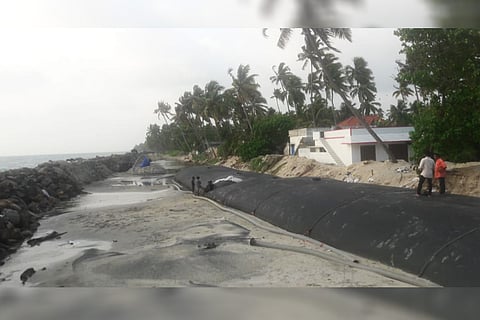

A year since Cyclone Ockhi hit Chellanam, a coastal village in Kochi, residents’ need for a solution to counter sea erosion is yet to be met. The geotube seawall project started by the Ernakulam district administration after Cyclone Ockhi to prevent sea erosion has now come to a halt, creating panic among the residents with monsoon approaching in a few months.
The densely populated Chellanam panchayat in Ernakulam district has some homes not even 100 meters away from the sea. Sea erosion, which is loss or displacement of land due to waves and tides, has always been a problem for residents; especially during the monsoon when it causes damage to homes as well. Though a stone seawall exists in most of the region, some stretches of the panchayat do not have any barrier between houses and sea.
“Sea erosion was always a problem here during monsoon and Ockhi was the breaking point,” said Babu, a resident of Chellanam. “So, after the cyclone, the villagers took out a protest demanding a proper remedy. Many went on hunger strike too. It was in December 2017 that the authorities promised that they would build a geotube seawall here as there is a lack of stones.”
The project entails geotubes, which are made of natural or synthetic polymers, to be filled with sand and stacked as a wall along the coast to prevent sea erosion. One unit of geotube is 25 metres in length and 4.5 metres wide. One unit of seawall will be nine-meter-wide and about a man’s height to prevent waves from entering the houses nearby.
The geotube seawall was supposed to be completed by early April 2019. However, the work has been halted since the past three weeks and the project is not even halfway through. Protesting against the same, residents of the village conducted a dharna on Wednesday before the Revenue Divisional Office in Fort Kochi.
The Rs 8 crore project was to help protect severely affected areas across four different stretches which have no barrier against the sea - Velankanni Bazaar (300 metres from the sea), Vachakkal (100 metres from the sea), Companypady (300 metres from the sea) and Puthenthode Fishing Gap (110 metres). At present work has only begun at the Velankanni Bazaar stretch.
“Though the project was flagged off last year, the work on ground began by this January. We don’t think that the work will be completed on time at the present pace,” Babu added.
Roadblocks
K Radhakrishnan, executive engineer at the Irrigation Department and in-charge of the project told TNM that though the funds were approved in May last year, the delay happened because the geotubes were being made outside Kerala. “We received the finished geotubes by December end and started the work by January,” he said.
Now however, they have run into a hurdle due to unavailability of sand to fill geotubes. According to the residents in the area, the contractor had taken sand from near the shore, which the villagers opposed. “If sand is taken from the waters near the shore, it will again increase sea erosion. They were already given directions to dredge from a particular distance but they just pumped sand from near the shore. Villagers stopped this when they saw it,” said Josey, a resident of Chellanam.
“The contractor was supposed to take sand from the sea but they do not have adequate facility for the same. We will wait about a week to monitor how they function; if found unsatisfactory, action will be taken against them,” said Radhakrishnan.
Josey also said that sea erosion became worse in the region after sea breakers were constructed in a fishing harbour there. “Three years ago, two sea breakers were built about a kilometre from Companypady to aid the fishing harbour. While that has prevented violent waves from entering the harbour premises, but the pulls of waves have made erosion severe in other areas. So, a seawall has become necessary in this area,” he added.